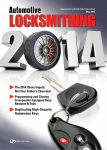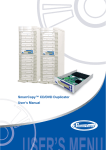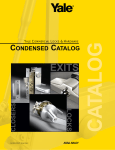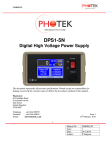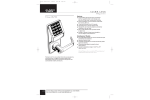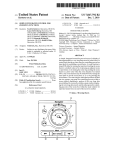Download document - Locksmith Ledger
Transcript
SPECIAL PROGRAMMING SECTION: PROGRAMMING KEYPAD-ONLY STANDALONE ELECTROMECHANICAL LOCKS by Jerry Levine I t has been more than 15 years, since I first wrote about standalone, single door electromechanical locks. These first locks were equipped with only a keypad as the credential required for gaining access. They were programmed at the door; some could only program one user at a time. They have different types and numbers of batteries to release the locking mechanism. No time, no date, no audit trail or intranet connection for most of them. Only the master code and/or programming code or sometimes sub-masters or supervisors codes and the user codes operate these standalone electromechanical keypad programmed and operated locks. These self-contained single door access control units are comprised of two components; the electronics and the modified leverset. The electronics include the keypad, circuit board, LED’s, battery pack and the locking/unlocking mechanism. The modified leverset was usually like a Storeroom function, keyed outside and free egress. When the lock was unlocked electronically, the outside lever was rotated to gain access. Using the mechanical override, rotating the key in the lock cylinder would retract the latch, the outside lever was usually not unlocked. A number of these locks are still in daily use. Locksmiths will get service calls to program or be asked for help in order to program one or more of these locks. The purpose of this article is to provide general information and programming information on these keypad programmed locks. Locks discussed are the Alarm Lock DL2700, Arrow Revolution, Code Locks CL5000, Kaba Ilco E-plex 4000, Marks i-Que, Sargent KP, Schlage Cobra, Securitron SABL™ and Yale eBoss. A photo will be included for each lock as not all locks have their name and model number visible for easy identification. 46 — LOCKSMITH LEDGER [11/10] Note: I have attempted to choose the oldest lock available from each of these manufacturers. Some of these locks have been discontinued or are in the process of being discontinued, but are still in daily operation. I have developed a chart for listing the basic information for each manufacturer’s product. General information will include ANSI/BHMA Grade, UL/ cUL Fire Rating, available lock configurations, lever handing, key override option, keypad layout and button construction. Some of these features will help to identify the product as well as provide needed information for servicing and re-installation. For example, the Marks i-Que Metro has a 16-button keypad. The buttons are arranged in four rows, four buttons per row. The 16 button layout is: Top row 123i Upper Row 456Q Lower row 789u Bottom row *0#e The four buttons on the right side vertical spell “iQue”.They can be used as part of the PIN. The next section of each chart will include information on the Master, Sub-Masters and “use” Codes. A “use” code unlocks the lock and includes User Codes, Emergency Codes and Service (single use) Codes. The Emergency Codes normally have an extended length unlock time for those individuals who need more time to access the lock. An Emergency Code can for some manufacturers provide access when the batteries are almost exhausted. The Service Code is a one-time User Code that erases itself immediately after use. It is normally programmed like any User Code. The Code section will include the number of codes, their hierarchy, digits per code, default codes, and user groups. For example, the Alarm Lock DL2700 has one Master Code that can be configured from three to five digits. The hierarchy has one Management Code and the User Codes. The length of the Master Code determines the Management and User Codes/Service Code lengths. The Master and Management Codes program the lock as well as operate the lock. The Service Code is a single “use” code that is designed for service personnel, vendors, etc. For most locks, the single “use” code is programmed and disappears after it has been used. Only a Master and/or the Submaster Code can program the Service Code. The Codelocks CL5000 Series can have up to ten single “use” codes in addition to the regular User Codes. Battery life varies by lock. Each manufacturer uses the number and size of batteries they believe will provide maximum cycle life. Most manufacturers use “AA” batteries. One manufacturer uses “C” batteries. Each manufacturer provides the number of cycles. Even though these cycle numbers may last longer than one year’s operation, most manufacturers recommend replacing batteries every year to insure uninterrupted operation. All of the manufacturers recommend using alkaline batteries. Lithium batteries are not recommended. Some lock manufacturers have a two stage warning. For example, Securitron SABL low battery warning begins with two short beeps and flash of the LED’s at first keystroke. The second stage warning is two short beeps and the LED flash at each keystroke. And finally, what might be the most important programming set of instructions, the instructions for resetting the lock when the master code is lost. We have condensed the basic programming operations; for detailed instructions, contact the lock manufacturer. www.locksmithledger.com SPECIAL PROGRAMMING SECTION: ALARM LOCK DL2700 Categories Alarm Lock DL 2700 Grade 1 ANSI/BHMA A156.2 Cylindrical Lock Grade UL/ULC fire rating 3 Hours, “A” labeled doors Cylindrical or mortise Cylindrical Clutched Lever Yes Lever Handing non-handed (field reversible) Yes Key Override Yes Optional No Keypad Layout Telephone Style, 12 button Button Construction Metal Code Hierarchy Master, Management, User Codes Master Code One Number Of Digits 3 to 5 Factory Default Master 1-2-3-4-5 Note: Changing Master erases all codes Sub-Master Codes no. 1 Number Of Digits Same as Master User Codes Up to 15 number of digits Same as Master Single use code Up to 2 (Service Code) Successful entry Beeps sounds, Green LED flashes User code groups 3, 5 codes per group Levels of access Code Required, Passage, User, Group or All Lock-out Lock-out Override Master or Management Programming Capabilities: Master Code All Sub-Masters Limited Anti-Tamper 3 invalid code entries shuts down lock for approximately 20 seconds 2 beeps when reactivated Battery Life Up to 175,000 cycles Weatherized model Optional Low Batteries Warning 5 second dual tone when any key is pressed Batteries 5AA Alkaline Battery Location Interior Housing, Screw at bottom www.locksmithledger.com T he Factory Master Code (12345) may not be used for programming; a new Master Code must first be programmed into the lock. All other codes must have the same number of digits (3-5) as the new Master Code. Programming New Master Code: Enter existing Master Code, then Program Address before unit relocks. Enter new Master Code, then press [AL]. Verify as follows. Press 12354 (factory master code), hear beep, [AL] [1] [AL], new master code number, [AL] again. To verify, enter new master code again and you should hear 6 beeps. Management Code: Enter Master Code, then [AL] [2] [AL] (before unit relocks. Enter Management Code. You should hear 6 beeps. User 1 Code: Enter Master or Management Code, then [AL] [1] [1] [AL], then enter User 1 Code. Again, 6 beeps means programming was successful. User 2 Code: [AL] [1] [2] [AL], User 2 Code User 3 Code: [AL] [1] [3] [AL], User 3 Code User 4 Code: [AL] [1] [4] [AL], User 4 Code User 5 Code: [AL] [1] [5] [AL], User 5 Code User 6 Code: [AL] [2] [1] [AL], User 6 Code User 7 Code: [AL] [2] [2] [AL], User 7 Code User 8 Code: [AL] [2] [3] [AL], User 8 Code User 9 Code: [AL] [2] [4] [AL], User 9 Code User 10 Code: [AL] [2] [5] [AL], User 10 Code User 11 Code: [AL] [3] [1] [AL], User 11 Code User 12 Code: [AL] [3] [2] [AL], User 12 Code User 13 Code: [AL] [3] [3] [AL], User 13 Code User 14 Code: [AL] [3] [4] [AL], User 14 Code User 15 Code: [AL] [3] [5] [AL], User 15 Code Service Code: [AL] [3] [AL], Service Code User Code provides entry only. To disable any user, enter Master or Manager Code, respective program address, but no User Code. Allow unit to relock. FUNCTIONS To program the following functions, first enter Master or Management Code, then respective program address before unit relocks. Disable Bank 1 Users: [AL] [5] [1] [AL] Disable Bank 2 Users: [AL] [5] [2] [AL] Disable Bank 3 Users: [AL] [5] [3] [AL] Disable Banks 1-3: [AL] [5] [5] [AL] Re-enable Bank 1: [AL] [4] [1] [AL] Re-enable Bank 2: [AL] [4] [2] [AL] Re-enable Bank 3: [AL] [4] [3] [AL] Re-enable Banks 1-3: [AL] [4] [4] [AL] Enable Passage: [AL] [4] [AL], programmable by Master only Disable Passage: [AL] [5] [AL], programmable by Master only Battery Replacement: Must be replaced within two minutes to avoid losing memory. Do not press any buttons when replacing batteries RESET PROGRAMMING TO FACTORY DEFAULT: Remove batteries and press any button [11/10] LOCKSMITH LEDGER — 47 SPECIAL PROGRAMMING SECTION: ARROW REVOLUTION PIN CODE PROGRAMMING EASY MODE PIN code programming in the Easy Mode requires the “I” button to enter the programming mode. Adding or changing codes deletes all existing PIN codes. 1. Unscrew battery cover hex screw using tool provided. Slide battery cover up and off to reveal the “I” button located above the batteries. 2. Press the “I” button once. Lock response: Register User code. Enter 1 Supervisor then up to 8 users. Enter 4 to 12-digit PIN, followed by “#” key. Press “I” button to complete. 3. Enter the new Supervisor PIN (4 to 12 digits) followed by the “#” key. Lock Response: Sounds a tone for each PIN digit with digits flashing in the sequence entered to confirm the entry. Chime signals when playback is complete. 4. Enter the first User PIN code (4 to 12 digits) followed by the “#” key. Lock Response: Same as 3. 5. Enter additional User PIN codes (4 to 12 digits) followed by“#” key. Up to 8 User PINs can be entered. 6. Press “I” button to complete the process after the last playback sequence. Lock Response: “Registered.” Notes: The “*” key is used to enter or accept an entry, and also to conclude a programming session. The “#” key is used to enter or to continue additional steps in a programming sequence. RESET PROGRAMMING TO FACTORY DEFAULT: Remove inside lever. Remove battery cover using Allen wrench provided with lock. Remove batteries. Remove screw from battery housing. Remove inside escutcheon. On PC board, change position of EASY/ADVANCED switch. This deletes all prior programming. The Arrow Revolution can be programmed in the Advanced Mode having up to 1,000 Users. The Advanced Mode includes a Master Code for programming, not access. This mode divides Users into 20 Supervisor Groups of 50 per group. 48 — LOCKSMITH LEDGER [11/10] Categories ANSI/BHMA A156.2 Cylindrical Lock Grade UL/ULC fire rating Outside Lever Notes: Cylindrical or mortise? Lever Handing Field reversible? Key Override Optional Keypad Layout Button Type Code Hierarchy Master Code Number Of Digits Factory Default Master Code Notes: Arrow Revolution Grade 2 UL - cUL Fire Label for all functions up to 2 hours Free Wheeling Outside lever disengages when locked Cylindrical, mortise Non-Handed Yes Yes Yes 12-Button telephone style Touch screen Easy Mode (Nine Users), Supervisor, Users Supervisor PIN Four to 12 1-2-3-4-5-6-7-8-9-0 Supervisor PIN Factory default setting is Easy Mode. Arrow uses PIN instead of code Not in Easy Mode up to 8 Four to 12 digits Sub-master Codes User Codes no. number of digits Note: When adding or changing PINS, all existing PINs are deleted and must be re-entered. Single use (service code) n/a Successful Entry User code groups Levels of access When correct code and “*” or palm touch is entered, the illuminated display roles upward, like a window blind opening. n/a Code Required, Passage, Lockout Advanced mode only Lock-out/down Programming Capabilities: Codes on hold n/a Anti-Tamper Five unsuccessful attempts at entering a valid PIN code the unit will shut down and not allow operation. Weatherized model Weather resistant Battery Life Approximately 20,000 operations Low Batteries Warning n/a Batteries Four AA Alkaline Batteries Battery Location Inside back cover Battery Replacement 3/32” hex wrench Information Warnings 9 Volt battery connections under front of exterior escutcheon for emergency power www.locksmithledger.com SPECIAL PROGRAMMING SECTION: CODELOCKS CL5000 CHANGE MASTER CODE KEY Key Sequence: # Master Code: Enter length of Master Code Followed by new Master Code (eg 6, 123456) Confirm length of Master Code followed by new Master Code (eg 6, 123456) Result: Master Code now changed to #123456. Note: If the length of the Master Code is changed, then all previous User Codes will be deleted Add/Change Sub-Master: (Program 13) Key Sequence: #Master Code, 13, Sub-Master Code (eg 2468) Result: A SubMaster Code #2468 has been entered Delete Sub-Master Code: (Program 14) Key Sequence: #Master Code, 14, 14. Result: Sub-Master Code has been deleted Enter New User Code: (Program 01) Key Sequence: #Master Code, 01, User Code ID (eg 05), New Code (eg 4321) Result: New Code 4321 entered as User Code ID 05 (when user enters code) One Time User Codes: (Program 07) Key Sequence: #Master Code, 07, One time code ID (eg 81), One time Code (eg 4321) Result: Code 4321 in position 81 will work once and then be removed from memory Note: ID Positions 81 to 90 reserved for program functions, allowing up to 10 One-Time User Codes. Suspend User Code: (Program 02) Key Sequence: #Master Code, 02, User Code ID (eg 05) Result: User Code at ID 05 suspended (when user 05 enters code) Restore User Code: (Program 03) Key Sequence: #Master Code, 03, User Code ID (eg 05) Result: User Code at ID 05 restored (when user 05 enters code) Suspend All User Codes: ( Program 04) Key Sequence: #Master Code, 04. Result: All User Codes suspended (when all users enter code) Restore All User Codes: (Program 05) Key Sequence: #Master Code, 05. Result: All User Codes restored (when all users enter code) Delete All User Codes: (Program 12) Key Sequence: #Master Code, 12, 12, (7 secs). Result: All User Codes will be cleared from the memory Set Passage Mode: ( Program 08) Key Sequence: #Master Code, 08. Result: Lock will be continuously unlocked Cancel Passage Mode: (Program 09) Key Sequence: #Master Code, 09. Result: Lock will revert to normal operation RESET TO FACTORY DEFAULT: Remove 1 battery. Press and hold ‘0’ button. Blue LED will flash twice, and beep will sound twice. Release the ‘0’ button. Within 3 seconds, press the ‘*’ button 3 times. Blue LED will light continuously for 7 seconds, then 2 beeps will sound. lock will revert to factory set Master, #-1-2-3-4, and all other settings will be erased. 50 — LOCKSMITH LEDGER [11/10] ANSI/BHMA Grade UL/ULC fire rating Clutched Lever n/a Listed Freely rotates until proper code is entered Available as Cylindrical Lever Handing Non-handed Field reversible? Yes Key Override: Yes Optional: No Key Function: Lock cylinder provides emergency override and change between passage and code required Keypad Layout Telephone Style, 12-button Button Construction Stamped stainless steel Code Hierarchy Master, Sub-master (optional), User Codes Master Code 1, must start with # Number Of Digits 4, 5 or 6 Factory Default #-1-2-3-4 Master Sub-master Codes One, must start with # Number Of Digits Same as Master Code User Codes. Up to 80 number of digits Same as Master Code Single use (Service Up to 10 code) Successful Entry Blue LED blinks twice and two beeps Levels of access Code Required, Passage, Lockout Lock-out/down Suspend all users Overridden by Master or Sub-master Programming Master Code cannot gain Capabilities entrance Master All functions/Sub-Master optional Notes: Programming a code each button press must be entered in 5 seconds, or red LED will flash, beep and lock will revert to normal. Codes on hold Suspend all users Anti-Tamper Entering 3 incorrect User codes will cause lock to suspend activity for 10-second penalty Weatherized model Weather resistant Battery Life Over 200,000 operations Low Battery Red LED will flash 5 times Warning before the Blue LED blinks twice and beeps twice to signal acceptance of the code. Batteries should be changed as soon as this happens. Batteries Four AA Alkaline Battery Location Inside back cover Warning: Non-volatile memory www.locksmithledger.com SPECIAL PROGRAMMING SECTION: UNICAN 4000 Disable Users: 0, 00#, all code (except Master) 0, 0M#, Manager of Group M (1-6) 0, GO#, All users in Group G (1-6) 0, GU#, User U (1-9) in Group G (1-6) 0, 77#, Service access code Activate Users: 1, 00#, All codes except master 1, 0M#, Manager of Group M (1-6) 1, GO#, All users in Group G (1-6) 1, GU#, User U (1-9) in Group G (1-6) 1, 77#, Service access code Delete Users: 3, 00#, all codes (except Master) 3, 0M#, Manager of Group M (1-6) 3, GO#, All users in Group G (1-6) 3, GU#, User U (1-9) in Group G (1-6) 3, 77#, Service access code Passage Mode: 4, 00#, Off – Normal Operation 4, 01#, On – No code required to open door Lockout Mode: 4, 90#, Off – Normal Operation 4, 91#, all codes, On, All user access codes temporarily locked out, Master & Manager Codes still accepted for programming Unlock time setup: 5, SS#, select 1-20 sec to turn handle after entering valid code Add/Modify Users: 2, 0M#, Manager of Group M (1-6) 2, KKKKKKK#, enter 7-digit code 2, GU#, User U (1-9) in Group G (1-6) 2, KKK(KKK)#, enter 3-8 digit code, same length as all other access codes 2, 77#, Service access code 2, 99#, Master authorization code 2, MMMMMMMM, enter 8-digit code, M#, re-enter 8-digit code to confirm, MMMMMMMM www.locksmithledger.com Factory Defaults: 9, 99#, restores factory default settings and erases all codes except the Master Code. Note: There is a programming time limit. More than 5 seconds between key strokes exits programming mode Battery Replacement: Remove shrink wrap on old batteries if necessary. If lock in passage mode, lock reverts to locked mode. RESET TO FACTORY DEFAULT: To reset programming to factory default, remove inside housing from door. Press and hold reset button for one second. Categories Unican 4000 ANSI/BHMA A156.2 Grade 1 Cylindrical Lock Grade UL/ULC fire rating 3 Hours, “A” labeled doors Available as Cylindrical/Mortise Clutched Lever Yes Lever Handing non-handed Field reversible? Yes Key Override Yes Optional No Keypad Layout Telephone Style, 12-button Button Construction Metal Code Hierarchy Master, Manager, Privileged User, User Master Code One Number Of Digits 8 Factory Default 1-2-3-4-5-6-7-8 Master Code Notes: Lock will not accept factory default Master Code Sub-master Codes 6 Number Of Digits 7 User Codes Up to 54 number of digits 3 to 6 Notes: 1st User Code determines length Single use code 1 (Service Code) Successful entry Clutch engages, Green LED flashes continuously, ½ second beep User code groups 6, up to 9 users per group Levels of access Code required, Passage, Privacy/lockout, lockout Lock-out/down Master or Manager Override Code Programming Capabilities: Master Code All Sub-Masters Limited Time Limit More than 5 sec btn keystrokes exits programming mode Codes on hold Users Lockout Anti-Tamper After 3-6 invalid codes, all User Codes locked out 30 secs - 15 min. Entering codes during Weatherized model Weather resistant Low Batteries Warning Alternating green and red LED and buzz when access is granted Batteries 4AA Alkaline Battery Location Interior Housing, 2 5/64” hex screws [11/10] LOCKSMITH LEDGER — 51 SPECIAL PROGRAMMING SECTION: MARKS I-QUE METRO Categories ANSI/BHMA A156.2 Grade Certification UL/ULC fire rating Clutched Lever Cylindrical or mortise? Lever Handing field reversible? Key Override Optional Keypad Type Button Construction Code Hierarchy Master Code # Characters Factory Default Sub-master Codes # # Characters User Codes # Characters Single use code Successful Entry User code groups Levels of access Lock-out/down Overridden by Programming Capabilities Metro Grade 1 ‘A’ Label doors Yes Cylindrical/Mortise, Exit Trim/Tubular non-handed Yes Yes No 16 buttons 123i, 456Q, 789u, *0#e flush or tactile metal System Manager/GGM, Choice of lower levels, User Codes Great Grand Master (GGM) Code 5-10, Combination of UID + PIN 9991234, Factory Code becomes GGM “GM” “M” Same as the GGM up to 32 Same as the GGM No Green LED, 1 sec double beep Up to 99, Users in the same group have same access rights Passage, Code Required, Multiple Code Entry, Deny Access by Group Master Code System Manager program only, “GGM”, “GM”, “M” no change own UID Codes on hold Deny Access Anti-Tamper 3 wrong codes, keypad locked out for 20 seconds, then increases to 40 Battery Life 80,000 to 90,000 operations Low Battery Warning First stage: double beep & yellow LED when code entered Second stage: adds a double beep every hour till batteries fail. Batteries 4 AA Alkaline Battery Location Interior battery cover Battery Replacement Must be replaced within 10 minutes or memory affected 52 — LOCKSMITH LEDGER [11/10] 1. INITIALIZE LOCK. Initializing the lock with a unique 6-digit code assigns a LOCK ID number to each specific lock. Using keypad, enter the FACTORY CODE 9991234, the #key, and the 6-digit LOCK ID (usually starting with 000001), and finally, the #key. This code will NOT open the lock. 2. Create GREAT GRAND MASTER (GGM). This code is required by the SYSTEM MANAGER to perform all programming functions. In any lock system, the number of digits used for the UID of each User must be the same. Example: If the UID is 3 digits, all Users must have a 3 digit UID code. Also, the number of digits used for the PIN of each User must be the same. Example: If the GGM’s PIN is 5 digits, all Users must have a 5-digit PIN code. Using keypad, enter the FACTORY CODE 9991234, the * key, the UID of the system manager (either 2,3 or 4 digits), the #key, the PIN of the system manager (either 3,4,5 or 6 digits), and finally, the #key. Factory Code * UID (2, 3 or 4 digits) PIN (3, 4, 5 or 6 digits) # 9-9-9-1-2-3-4 * 1-2-3 # 1-2-3-4-5 # The GGM is now established for the SYSTEM MANAGER only a combination of their UID followed by their PIN. Lock is now initialized. System Manager’s Access to the Lock: Enter UID plus PIN, then the *key. Example: 1-2-3-1-2-3-4-5 *, GGM *. Function 01, Adding & Deleting User Codes. Min. Group Number 03 To Add Users: Enter YOUR CODE (UID and PIN), the #key, FUNCTION NUMBER (01), the * key, the Users UID you want to include in the GROUP, the * key, the 2 digit GROUP NUMBER, the * key, the User’s PIN, the * key twice. Example: 1-2-3-1-2-3-4-5 # (your code), followed by 01 * (function #), 678 * (UID), 04 * (Group number), 5678 * (PIN), * To Delete Users: Enter YOUR CODE (UID and PIN), the #key, FUNCTION NUMBER (01), the *key, the Users UID you want to delete, the *key, the 0 key in place of the GROUP NO., the *key twice. Example: 1-2-3-1-2-3-4-5 #, 01*, 678*, 0* * The System Manager Code establishes the GGM and performs all programming functions.Higher Groups can override access functions of lower Groups. All Users must be assigned to a Group. Each assigned Group can have different User restrictions. When programming a Marks i-Que Metro, important keys are: TERMINATOR KEY (*): Acts like the “Enter” key on a computer and is used to add or confirm codes on the keypad. PROGRAMMING KEY (#): After a valid PROGRAMMING CODE is entered, this key is depressed to enter the programming mode. This key can also be used as a time saving feature, allowing the entry of multiple functions. At the end of any PROGRAMMING INSTRUCTION, replace the last * with a # to return to FUNCTION NUMBER input, eliminating the need to reenter YOUR CODE. RESET PROGRAMMING TO FACTORY DEFAULT: Unplug battery pack. Find black and yellow wire connector. Make wire “U” and insert into connector. Plug in battery pack, LED red then green. Lock should relock. Remove “U” wire. Re-assemble lock. www.locksmithledger.com SPECIAL PROGRAMMING SECTION: SARGENT KP LOCK S argent KP Lock factory Master Code is “1234”. Entering 1234* unlocks and allows lever to retract latchbolt. All of the following procedures start with 99# to enter programming mode. Change Master Code: 1234* (Yellow LED Begins to Blink Slowly). This example uses the Factory Default Master Code 50# 1# 01# New Master Code* (Yellow LED Blinks Quickly) . New Master Code* (Yellow LED Blinks Slowly) *(Yellow LED Goes Out) Enter Emergency Code: (Unlock Duration Factory Set at 10 Sec) Master Code* (Yellow LED begins to blink slowly) 50# 1# 02# Emergency Code* (Yellow LED blinks quickly) Emergency Code* (Yellow LED Blinks Slowly) * (Yellow LED goes out) Enter Supervisory Code: Master Code* (Yellow LED begins to blink slowly) 50# 1# 03# Super visory Code* (Yellow LED blinks quickly) Supervisory Code* (Yellow LED Blinks Slowly) *(Yellow LED goes out) Enter User Code: Supervisory or Master Code* (Yellow LED begins to blink slowly) 50# 1# User Number (04-97)# User Code* (Yellow LED blinks quickly) User Code* (Yellow LED blinks slowly)* (Yellow LED goes out) Enter Passage (Maintained Mode) Code: Supervisory or Master Code* (Yellow LED Begins to blink slowly) 50# 2# User Number (04-97)# User Code* (Yellow LED blinks quickly) User Code* (Yellow LED Blinks Slowly)* (Yellow LED goes out) Enter One-Time User Code: Supervisory or Master Code* (Yellow LED begins to blink slowly) 50# 3# User Number# User Code* (Yellow LED blinks quickly) User Code* (Yellow LED Blinks Slowly) * (Yellow LED goes out) Clear Entire Memory: Master Code* (Yellow LED Begins to Blink Slowly) 46# 00000# 00000# (Yellow LED Continues to Blink Slowly) * (Yellow LED Blinks Quickly) 54 — LOCKSMITH LEDGER [11/10] * (No Beep on Depression and Yellow LED Goes Out) PAUSE, Yellow LED Begins to Blink Again * (Yellow LED Goes Out) Note: This deletes ALL codes, including Master, Emergency and Supervisory. Master Code is set back to 1234, Door Number to 0001 and Unlock time 5 Sec. If the Master Code is unknown, Factory Assistance will be required to clear the memory. Call 1-800-810-WIRE Categories Sargent KP ANSI/BHMA A156.2 Grade 1 Lock Cylinder Grade UL/ULC fire rating 3 hour ‘A’ label doors Clutched Lever n/a Available as Cylindrical, Mortise or Exit Device Trim Lever Handing Some non-Handed Field Reversible? Yes Key Override Yes Optional No Keypad Layout Telephone-Style 12-button Button Construction ultraviolet stable textured material Code Hierarchy Master, Emergency, Supervisor, Users Master Code # Digits 2-6, Notes: Can repeat numbers or start Yellow indicates programming with “0”. Factory Default Master 1-2-3-4 Notes: Only Master code deletes Users. Sub-master Codes # 1 Emergency, 1 Supervisor Number Of Digits 2-6 User Codes no. up to 96 # of digits 1-6 Notes: Can be different lengths, Can repeat numbers. Two User Codes have 10 sec open time (98, 99) Single use code Up to 96 Successful Entry Green LED, pasage mode, flashing green LED User code groups n/a Notes: When Passage Mode is activated, same User Code must be used to re-lock Lock. Levels of access Code required, passage Programming Capabilities Master Code: all, Emergency Code :10 second unlock time Supervisor Code limited, No Users deleted by Supervisor Code Codes on hold Temporary Lockout Anti-Tamper 3 wrong codes in succession disables all codes for 10 seconds Battery Life Minimum 40,000 cycles Low Batteries Warning Four chirps after each code entry Batteries Four “C” Battery Location Inside of Battery cover, secured with 8-32 hex head security screw Battery Information Warnings Non-volatile solid state memory Notes: If a mistake is made during any programming procedure, depress the “*” several times until the yellow LED goes out. If no keystroke is made in a 30 seconds, the unfinished programming up to that point will default and you will have to start over. If after the last “*” is depressed, the yellow LED does not go out, depress “*” once more. www.locksmithledger.com SPECIAL PROGRAMMING SECTION: SCHLAGE COBRA T he Cobra lock does not have Master or Sub-Master Codes. Instead, application codes include: Normal Codes, Toggle Codes that either unlock (passage mode) or relock (Code required) and Freeze/Lockout Codes that unlock or relock locks, and prevents other codes from operating the locks. One Use Codes unlock lock only once for the unlocked time. Supervised Codes requires two different codes to unlock lock for the unlock time. Pass Thru Codes will unlock the door for the unlock time even in lockout mode. Add Normal User Code: Enter Program Code *, 3 *, Enter New Code, * *. To add more, enter new code * *. To end, *. Add One-Time User Code: Enter Program Code *, 33 *, 113 *, enter new code, **. To add more, enter new code **. To end, *. Add Toggle Code: Enter Program Code *, 33 *, 191, *. Enter new code, **. To add more, enter new code **. To end, *. Add Freeze/Lockout Code: Enter Program Code *, 33 *, 115 *, New Code, **. To add more, enter New code, **. To end, *. Add Supervised Code: Enter Program Code *, 33 *, 117, * New Code, **. To add more, enter New Code, **. To end, *. Add Pass Through Code: Enter Program Code *, 33 *, 119*. Enter New Code **. To add more, enter New Code **. To end, *. Change Programming Code: Enter Program Code *, 7 *, New Program Code, *, Enter New Program Code again, *. Delete Codes: Enter Program Code *, 5 *, Code to be deleted * *. To delete more, enter Code to be deleted **. To end, * Categories MPC Cobra Lock ANSI/BHMA A156.2 Cylindrical Lock Grade Grade 1 UL/ULC fire rating UL - cUL Fire Label forall functions up to 3 hours Clutched Lever n/a Available as Cylindrical Lever Handing Non-handed Field reversible? Yes Key Override Yes Optional No Notes: Standard cylinder or 7-pin IC Keypad Layout 6 buttons, 2 rows, 1-2, 3-4, 5-6, 7-8, 9-0, * Notes: Each keypad button represents two numbers. For example, code 246 is identical to code 135) Button Construction Metal Code Hierarchy Programming Code, Normal Code, Toggle Code, Freeze/Lockout Code, One Use, Supervised, Pass Thru Master Code Programming Code Number Of Digits 5-8 digits Factory Default 97531 Notes: Only programs codes Cannot unlock door Sub-master Codes no. n/a User Codes. Up to 99 number of digits 3-8 Notes: Six types of User Codes. Each has special applications Single use (Service Code) up to 99 Successful Entry Green LED flashes during unlock time, rotate handle to retract latch User code groups n/a Levels of access One Lock-out/down ovverridden by Freeze/Lockout Code Programming Capabilities Program Code only Codes on hold Freeze/Lockout Code Anti-Tamper n/a Weatherized model n/a Battery Life Approximately 80,000 cycles Low Batteries Warning First code entered, red LED flashes 12 times before the command executed. After about 500 cycles, lock goes into “Low Battery Lockout” mode. Freeze/Lockout Code required to gain access Batteries Four AA Battery Location Inside escutcheon cover, Four hi-Security Snake Eyes Screws Battery Replacement Warning Must replace batteries within 10 min TO RESET FACTORY DEFAULT: Clearing memory will delete all programmed codes and restore factory default codes. If the memory needs to be erased, follow these steps. 1. Remove inside escutcheon and remove one battery 2. Press any key 3. Hold down * key and reinstall battery. Continue holding the * key down until red LED flashes a few times and then stays on. 4. Release * key 5. Install inside escutcheon. To return to factory default relock time delay, do steps 1-4 twice in a row. www.locksmithledger.com [11/10] LOCKSMITH LEDGER — 55 SPECIAL PROGRAMMING SECTION: SECURITRON SABL Categories Securitron SABL ANSI/BHMA A156.2 Grade 1 Cylindrical Lock UL/ULC fire rating Clutched Lever Available as Lever Handing (field reversible) Key Override Optional Keypad Layout Button Construction Code Hierarchy Master Code Number Of Digits Factory Default Master Sub-master Codes User Codes no. Single use code Successful Code Entry (lock/ unlocked) Levels of access Lock-out Override Anti-Tamper Weatherized Battery Life Low Batteries Warning Batteries Battery Location Replacement 3-hour ‘A’ Label doors Clutched Exterior Lever Cylindrical Lock Non-handed Yes Yes No 11 buttons, 1-0 and “E” EPDM rubber keys Program Code, User Codes Program Code 5-7, only for programming Created Program Code is stored at address “00”. Must press “PRGM” button adjacent to batteries n/a up to 55, 2-7 digits n/a Flash once per second red LED. Can be reversed to green LED Code Required, Passage, Lock-out User locations 58 and 59. Code required to enter and exit Lock-out After 16 wrong digits entered, keypad will lock for 15 seconds, beeper sounds continuously Fully sealed exterior electronics Over 100,000 cycles Two short beeps and flash of LEDs at first keystroke. Second, two short beeps and LED flash at each keystroke 6 AA Alkaline Inside battery cover, 3/32” hex (Allen) wrench Non-volatile EEPROM memory, no time limitation 56 — LOCKSMITH LEDGER [11/10] CREATING THE PROGRAM CODE The Program Code is the password used to change programming. The program code is stored in address “00”. 1. Remove the battery access cover to gain access to the “PRGM” button. 2. Press “PRGM” button. 3. Yellow light on keypad will flash rapidly indicating program mode. While in the program mode, yellow light will continue to flash until exit the program mode or after a 30-second timeout period where there is no keystroke. 4. Press “00” for program code address. 5. Enter new 5 - 7 digit Program Code within 5 seconds. 6. When new Program Code is entered, wait for the red light to flash twice confirming valid entry. A long red flash indicates an error. SET USER CODES User codes are stored in addresses “01” through “55”. SABL must be in Program Mode to add or delete User Codes. 1. Enter Program Code. 2. Press “E” button. 3. Yellow keypad light will flash rapidly indicating program mode. 4. Press two digit prefix for new User Code address. 5. Enter new 1- 7 digit User Code within 5 seconds. 6. Wait for red light to flash twice to confirm valid entry. 7. Press “E” to exit program mode. To delete individual user codes, enter “79” then any User Code. To delete all users codes, enter “88” (not program or hard code). PASSAGE CODES OR LOCKOUT CODES The passage codes are stored in addresses “56” and “57”. Lockout codes are stored in addresses “58” and “59”. 1. Enter Program Code. 2. Press the “E” button. 3. Yellow keypad light will flash rapidly indicating program mode. 4. Enter “56” for passage code or “58” for lockout code within 5 seconds. 5. When desired code is entered, wait for red light to flash twice confirming valid entry. 6. Press “E” to exit program mode. To reverse passage or lockout code: Repeat above steps entering “57” to exit passage or “59” to exit lockout code within 5 sec. Red light flashES twice confirming valid entry. Press “E” to exit program mode. RESET TO FACTORY DEFAULT, MASTER CODE UNKNOWN: Press “HARD” button on CPU board for 1 second Flashing yellow LED. Press “E” key until flashing stops Confirm two (2) red flashes. Press the “PRGM” buttonon CPU board for one second. Confirm flashing yellow LED Enter 0-0 followed by “E” key. Confirm two (2) red flashes. Enter 8-8 followed by “E” key. Confirm two (2) red flashes. Enter 8-9 followed by “E” key. Confirm two (2) red flashes. Press the “E” key to end yellow flashing LED. Lock is back to default values www.locksmithledger.com SPECIAL PROGRAMMING SECTION: YALE eBOSS Categories ANSI/BHMA A156.2 Cylindrical Grade UL/ULC fire rating Clutched Lever Yale eBoss Grade 1 3 hours ‘A’ label doors Free wheeling only on Cylindrical and Exit Trim Available as Cyl/Mort/ET Lever Handing Non-handed Field reversible? Yes Key Override: Yes Optional Yes Keypad Layout Telephone-style 12-button Button Construction Stainless steel Code Hierarchy Master, Supervisor, User, Emergency, Lockout, Passage Code Master Code 4-7 digits plus *, Programming No access Factory Default Codes Master Code 1-2-3-4. Emergency Code 4-3-2-1 Notes: Factory master and emergency preset codes must change before codes can be programmed Sub-master Codes Supervisor, Lock-out, Passage Number Of Digits 4-7 plus * User Codes up to 94, 4-7 digits plus * Single use code n/a Successful Entry Green LED flash once per second upon entry of a correct User code User code groups n/a Levels of access Code Required Passage Lock-out/down Supervisor and Emergency Override Codes Programming Capabilities Master Code All programming Supervisor Code All programming except to change Master Code Lock-out Code Enables/disables lock-out for User Codes Passage Code Enables/disables passage mode Emergency Code Unlocks lock for ten seconds handicap Anti-Tamper (Default) After 3 successive invalid entries, 1 long red flash and tone. 10-sec keypad lockout, 1 short beep per sec Weatherized model Weather resistant keypad Battery Life 100,000 cycles Low Batteries Warning First, four beeps allows entry Blackout mode four beeps four tones Lock operates only with Supervisor and Emergency Codes Batteries Six AA Alkaline Battery Location Inside beneath battery escutcheon Replacement Info Non-volatile memory www.locksmithledger.com Change Master Code. EXAMPLE: Change from 1234 (factory default) to 3131. Hold # depressed until Yellow LED blinks continuously. Enter current Master Code (1234#). Yellow LED blinks. Enter Program Command Code (PCC). (51#) Yellow LED blinks Enter User Number (1#) Yellow LED blinks Enter New Master Code (3131#). Note: Master codes must be 4-7 digits Yellow LED blinks Re-enter New Master Code (3131#) Green LED Blinks If Master Code is unknown, Red LED will flash instead of Yellow. Refer to step 3. User Programming Commands. These Program Modes and User Codes can be programmed with the Supervisor Code (SC) or the Master Code (MC) Enter Master Code: # (Hold), MC#, 51#, 1#, (4-7 Digits)#, (4-7 Digits)# Enter Emergency Code: # (Hold), MC#, 51#, 2#, (4-7 Digits)#, (4-7 Digits)# Enter Supervisor Code: # (Hold), MC#, 51#, 3#, (4-7 Digits)#, (4-7 Digits)# Enter Lockout Code: # (Hold), MC#, 51#, 4#, (4-7 Digits)#, (4-7 Digits)# Enter Passage Code: # (Hold), MC#, 51#, 5#, (4-7 Digits)#, (4-7 Digits)# Enter Normal User Code: # (Hold) MC#, 51#, (6 through 99)#, (2-7 Digits) #, (2-7 Digits)# To delete all users (Deletes all codes back to defaults): #Hold, MC#, 60#, 60# To delete individual User Code: #Hold, MC#, 61# (6 through 99)# To delete block Of Users: #Hold, MC#, 62#, 1st LOC #, 2nd LOC # User Setting Reset: resets all programming commands to default. #Hold, MC#, 72#, 72# TO RESET PROGRAMMING TO FACTORY DEFAULT: To reset programming to factory default (master code unknown), Remove inside escutcheon. Press and hold “#” button until yellow LED blinks. Press PRGM button at top of controller. Enter 51#. Yellow LED blinks. Enter 1 #. Yellow LED blinks again. Enter new master code #. Yellow LED blinks. Re-enter new Master Code #. Yellow LED blinks. Green LED blinks. Lock back to default. [11/10] LOCKSMITH LEDGER — 57










